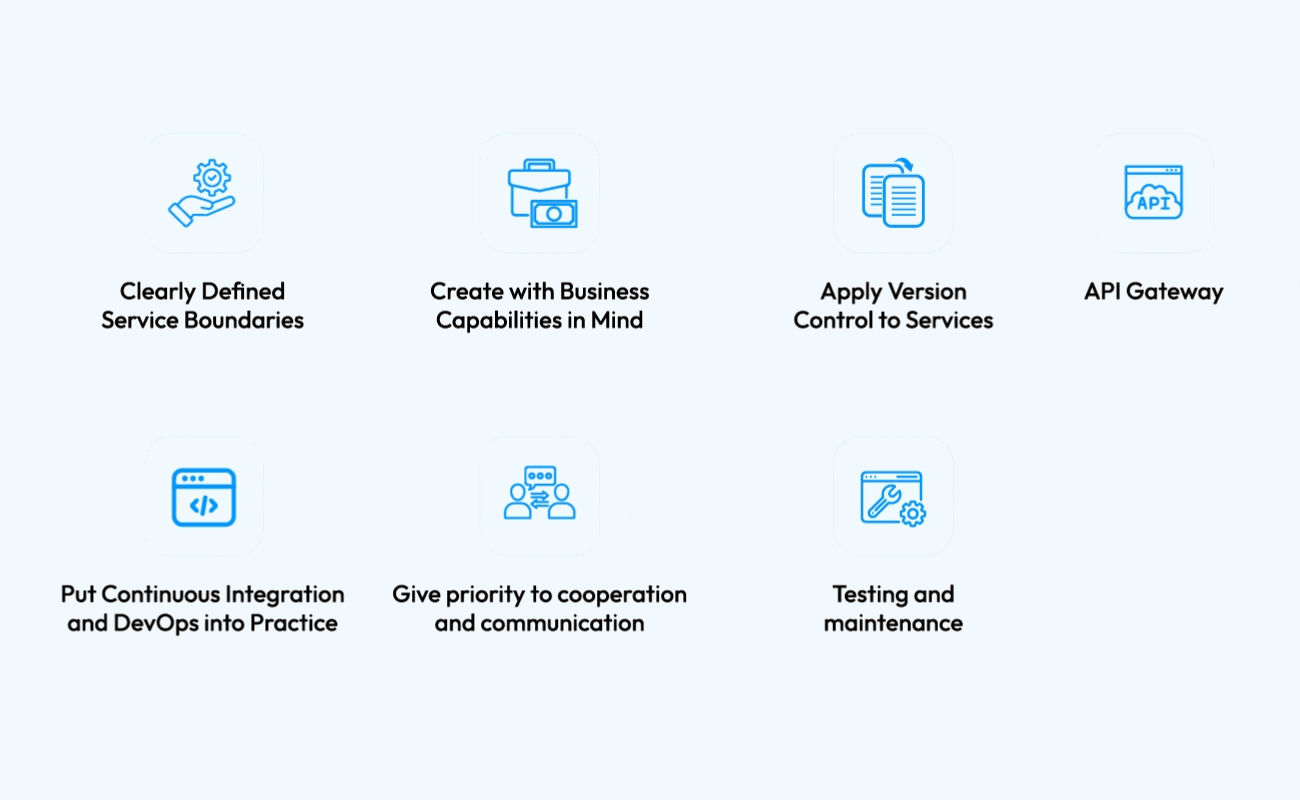Exploring Microservices Architecture: Benefits and Best Practices
-
Caploitte
-
19 July 2024
-
04 Min Read
What is Microservice Architecture?
The Benifits of Microservices
Top Practices for Developing Microservices
Conclusion
Even if you know a little about the software sector, you could be familiar with microservices architecture, a contemporary method of developing software programs that are becoming more and more well-liked by companies of all kinds. Agile approaches have accelerated code deployment and increased team productivity, while traditional software design frequently lags. Even well-designed setups frequently rely on a single code base and technology stack, running inside a common memory space, while many systems continue to be entangled in complicated actions. Microservices architecture is an architectural paradigm that has attracted a lot of attention for its ability to create and deliver software solutions to enterprises that are scalable, adaptable, and simple to take care of.
Complex applications can be divided into smaller, independent components with this architecture method, allowing for autonomous development, deployment, and scaling. Microservices are simpler to work with than a monolithic design since they operate separately, allowing developers to grow and manage one application without interfering with other microservices. We will explore microservices architecture in detail in this article, looking at its fundamental ideas, benefits, and best practices.
What is Microservice Architecture?

In software application development, microservices, also known as microservice architecture, is a kind of service-oriented architecture (SOA) in which the program is constructed from a group of connected services. Applications can be created as a collection of small, modular services thanks to microservices. By breaking the application up into smaller services, microservices provide more modularity. Every service can be independently built, deployed, and scaled, and each is responsible for certain functionalities. Most applications are “monolithic,” meaning they are developed as a single, self-contained entity. That encompasses the entire unit. This methodology promotes the utilization of highly coherent, loosely connected components, hence streamlining application upgrades and maintenance.
The Benifits of Microservices

We’ll go over a few of the clear, tangible benefits of adopting microservice architecture below.
– Increased Scalability:
Scalability is one of microservices’ most significant benefits. Every service could be separately scaled with microservices according to demand. Any component of a monolithic program is impacted by increases in user traffic. A monolithic application is just a large, interconnected chunk of code. With microservices, the scenario is much simpler. It becomes quite clear which microservice design is the bottleneck, which greatly facilitates the process of getting them to scale to meet demand. Thus, as website traffic rises, just the front-end services would need more resources. For example, since the database runs as a separate service with independent resources, it won’t be affected. This implies that companies won’t have to develop the entire application because they can give resources just where they’re needed. Due to the enhanced scalability, which helps minimize outages, users will always have an excellent experience.
– Better Fault Management and Adaptability:
If one part of a monolithic design breaks, the application as a whole could be impacted. On the other hand, services are segregated from one another in a microservices design. The failure of one microservice in a microservices architecture is less likely to negatively impact other software components since each microservice functions independently of the others. This implies that the unavailability of one service has no impact on the availability of other services. Microservices’ fault isolation feature makes the application more resilient overall by preventing system failures from being caused by the failure of a single service. However, as large distributed microservices architectures often have several connections, developers must protect the application against a shutdown due to a dependency failure.
– Simpler Upkeep:
Monolithic applications can be difficult and time-consuming to maintain and improve but with microservice teams can focus on certain services which makes upgrades and maintenance easier to handle. Since each microservice only handles a single task, it is easy to modify and optimize them for optimal performance. Faster development cycles are made possible by the ability for each service to be separately built, tested, and deployed.It is simpler to find and fix problems when services are separated, and it is also possible to upgrade or replace individual components without interfering with the operation of the overall program. Additionally, the modular development approach that microservices architecture fosters allows services to be developed and enhanced concurrently, allowing teams to efficiently expand their development efforts.
– Innovation and Diversification in Technology:
Microservices design enables companies to embrace heterogeneity in technology. Teams can use the most effective tools and frameworks for certain functions by having the freedom to select multiple technologies for each service. You can never be forced to use a poor solution indefinitely since different programming languages could be used to create different microservices inside the same larger application, depending on the situation at hand. This encourages creativity and gives groups the freedom to experiment with new ideas and technology. This customized strategy promotes creativity, quicker development cycles, and the best tool choice for every service. Additionally, it makes it possible for companies to implement cutting-edge technologies like serverless computing and containerization to increase scalability and efficiency even more.
– Effectiveness and Rapidity:
Enterprise applications can benefit greatly from the efficiency and agility that microservices architecture can provide. Developers can work more independently and release updates and changes more rapidly when the program is divided into smaller, easier-to-manage parts rather than waiting for the full thing to be rebuilt and redeployed. Different services can employ a variety of programming languages and technologies, giving users the freedom to select the ideal tool for each unique activity. This may result in more agile software development methods that can keep up with the quickly changing demands of the company, as well as quicker cycles for development and deployment.
Additionally, because underused or vacant assets can be assigned to other microservices that need additional capacity, microservices design can result in a more efficient use of resources. When developing a microservices-based solution, developers can incorporate any microservice that is developed in any language. They can also connect microservices running on different platforms.
Top Practices for Developing Microservices

Microservice development and implementation can be time-consuming. Here are some best practices grouped into categories that correspond to the development of the main stages of the software development lifecycle, from the moment you research microservice architecture for your next project until your final step of application deployment.
1. Clearly Defined Service Boundaries
A good microservices architecture must have well-defined service boundaries. Another important consideration is how they will interact with one another. Service interfaces must be thoroughly defined in order for them to be straightforward and well-documented. Every service should be accountable for a certain business capability, including data and functionality. This emphasis assists in the upkeep of readily maintained, loosely connected services. Furthermore, to ensure that services can communicate across all platforms and computer languages, think about using industry-standard protocols like GRPC or HTTP.
2. Create with Business Capabilities in Mind
Businesses should prioritize the business capabilities they wish to supply over the technical or implementation specifics when creating the microservices architecture. It ensures that a microservice is only utilized in a single context, leading to Domain-Driven Design (DDD). Create loosely coupled services with outstanding coherence that span a single limited environment. Businesses can prevent duplication of functionality across numerous microservices and guarantee that each microservice concentrates on delivering unique business functions by designing for business capabilities. Think about the possibility of security holes in a microservice architecture.
3. Apply Version Control to Services
Any software development project must have version control, but working with microservices makes it much more crucial. Every service ought to have a version control plan. Every service needs its own repository to provide clean version control records and easy access provisioning. Because every service has its own codebase, this allows for autonomous management of each service. You should use a version control system to guarantee that each service can be launched separately and to keep track of changes.
4. API Gateway
A proxy server that provides users with a single point of access to a variety of services is known as an API gateway. Serving as a go-between for clients and microservices, an API gateway streamlines communication, collects replies from various services, and handles permission and authentication. In order to maintain backward compatibility, I prioritize usability and versioning while designing APIs. Using an API gateway can improve performance and simplify your architecture while reducing network traffic. Additional features that an API gateway can provide include rate-limiting, tracking, and authentication. Adding an API gateway to a microservices ecosystem may improve security and reduce complexity.
5. Put Continuous Integration and DevOps into Practice
Businesses should use DevOps and continuous integration (CI) techniques to make sure the microservices architecture is created, deployed, and managed properly. The smooth collaboration of development and operations teams, as well as the timely and reliable deployment of updates and modifications, can all be ensured with the support of DevOps. The practice of regularly merging code changes to guarantee that there is always a current, functional version of the codebase is known as continuous integration (CI). With the use of continuous integration (CI), every microservice can be automatically tested and verified, and any problems or defects may be quickly found and fixed. Continuous delivery (CD) goes one step further, automating the deployment process to make code modifications easy and quick to push into production. Continuous Integration/Deployment (CI/CD) ensures that errors are found and resolved quickly in a microservices architecture that has several codebases to manage.
6. Give priority to cooperation and communication
Effective teamwork and communication abilities have a big impact on how a business runs. Businesses should prioritize cooperation and communication between operations teams, developers, and other stakeholders to ensure that all microservices can communicate efficiently and coordinate updates and changes. Making loose coupling between microservices requires the use of asynchronous communication mechanisms. By allowing services to operate independently of one another, this approach lessens the impact of changes or interruptions to one service on the others. It can guarantee that every component is in line with the aims and objectives of the business and that any problems are found early on in the development process and resolved.
6. Testing and maintenance
It’s critical to monitor your microservices once they’ve been released. It’s important to create an automated testing system that runs with each build and to monitor activity across all of your services. All of the data from these services can be seen as jigsaw pieces that you need to put together to obtain a full picture of how everything is operating. To evaluate the performance, stability, and scalability of your architecture, run unit, integration, and load tests. Maintaining a record of any modifications you make can also help you to trace back any necessary actions. Lastly, develop a strategy for long-term service maintenance. This entails limiting access to only those who are authorized and planning frequent upgrades and enhancements.
Businesses can guarantee that their microservices architecture is built, deployed, and managed properly and effectively and that they can fully benefit from this strategy, by adhering to these best practices.
Conclusion
The architectural design of microservices has completely changed how software is developed and maintained. Organizations can enhance their fault tolerance, scalability, and agility by segmenting large, complicated apps into smaller, independent services. The use of microservices in development processes has several advantages. It’s still not for everyone and that is why adopting microservices also necessitates thorough planning, strong DevOps procedures, and a clear comprehension of the related difficulties.
With innovations and trends like serverless architecture, event-driven architecture, and more, the future of microservices architecture is promising. Businesses can continue to use microservices architecture to be relevant and provide high-quality enterprise apps that satisfy their clients’ changing expectations by keeping up with these trends and advancements.
Share this post:
Read More
- All
- AI
- AR
- DevOps and CI/CD
- E-commerce
- FinTech
- IoT
- Mobile Development
- Outstaffing
- Security
- SEO
- Tech Trends
- Web Design
- Web Development




